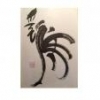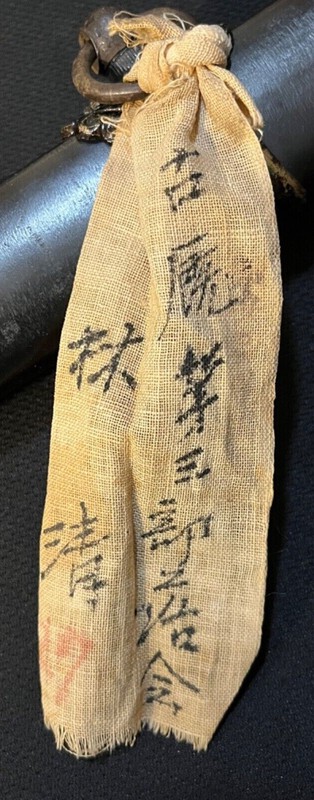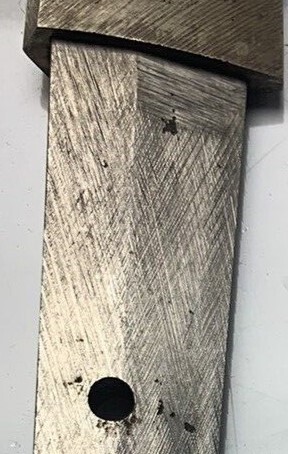-
Posts
630 -
Joined
-
Last visited
-
Days Won
5
Content Type
Profiles
Forums
Events
Store
Downloads
Gallery
Posts posted by mecox
-
-
Masatsugu has now been sold, thank you.
-
 2
2
-
 2
2
-
-
Price reduced to US1950.00 including shipping.
-
Its a hard one, possibly KANEYASU 兼安
-
 1
1
-
 1
1
-
-
Did you search NMB for Kunimitsu, there is some good info.
-
-
Keen to sell, reduced price and included shipping.
-
@John C @Bruce Pennington the kaigunto John found
Pic 1: stamp in circle of Toyokawa arsenal plus か "ka" katakana. The ink characters are assembly no. same as the fittings 941 九四一. Looks to be typical stainless steel blade.
Pic 2: ink writing looks like a name (is it the owner, or the assembler?) Suggestion is: SHIRAKI 白木 HIKOICHI 彦市 (shira is not clear).
Pic 3: probably a fault not a stamp.
-
 1
1
-
 2
2
-
-
@Bruce Pennington @John C IDO HIDETOSHI (井戸 秀俊) was a key tosho in the Amahide workshop in Seki and also commonly did daisaku with Amahide and others. various blades have the Amahide kokuin stamp, also a few other stamps e.g. "flaming ball" and a "one-punch". I have not seen an "8" but it looks more like OO ? That was a very productive workshop and there is a range of mei and stamp combinations due to daisaku and combined work.
-
 1
1
-
-
"Hizen Kuni Ju Masatsugu Kore Kinsaku" dated 1977, made at age 73. He was a fully trained smith and wartime Rikugun Jumei Tosho.
Nagasa 80.1 cm, sori 3.2 cm, hamon varied gunome-midare over notare. .
There is a paper with his full history of work and training showing numerous examples in NMB Downloads; this sword is on pages 33-34.
This is a very long sword and due to the overall length it will need to be shipped by courier, which is also more secure.
Type: katana shinogi-zukuri
Ubu: original condition with good polish in shirasaya.
Mei: "Hizen Kuni Ju Masatsugu Kore Kinsaku”
Papered: copy of Torokusho (Saga Education Committee, Showa 53 (1978) January 10); Aoi Art Appraisal with photos, full length traditional oshigata on scroll by Aoi Art.Also an informal “description paper” (not an assessment).
Era/Age: “Showa Hinoto-Mi Sai 12 gatsu kichijitsu” (lucky day 12th month Year of Snake, December, 2007)
Shirasaya: quality wood saya with clear grain. Comes with quality purple storage bag. Total length is 111 cm.
Nagasa/Blade Length : 80.1 cm (31 1/2 in); total length of blade + nakago 113.3 cm (40 6/8 in).
Sori : 3.2 cm (1 1/4 in) of koshi-zori.
Hamon Type : gunome-midare with ashi within long notare “waves”.
Jihada : ko-itame and ji-nie
Other Hataraki Visible : nioi-deki
Flaws : nil, perfect condition
Sword Location : Brisbane, Australia
Will ship to : selected countries giving permission.
Payment Methods Accepted : Paypal
Price and Currency : US$2500 including shipping and fees.
Other Info and Full Description : unusual long sword with deep sori attractive sugata. Possibly a custom order. Mei are clearly cut in Hizen style. Two piece copper habaki with gold foil on one piece.-
 4
4
-
-
Sesko listing: SANEYUKI (真行), Enpō (延宝, 1673-1681), Bungo – “Bungo no Kuni Takada-jū Fujiwara Saneyuki” (豊後高田住 藤原真行), Fujiwara-Takada school.
-
There are occasionally tosho not in lists but swords found. For Seki registration I think at least 4-5. Often they are later in the war and in an arsenal. In Seki there were a few late registration tosho (e.g. 1944) with "katsu" e.g. Katsunori and Katsufusa. Some are young some are old.
-
 1
1
-
-
Here are some other Kaneyoshi, and listed as Okada , some look like yours but depends on how mei is cut?
(1) - 関住岡田兼義作 Sekiju Okada Kaneyoshi - 日本刀の通信販売 明倫産業株式会社 (nipponto.co.jp)
here is an Okada Kaneyoshi......his 兼義 cut looks like yours ??
(2) 【研ぎ上がり・斬れ味保証】「濃州関住兼義」66.4cm 、鑑賞に・居合・試斬刀として!!! (ikedaart.net)
(3) 濃州関住岡田兼義作之 附九八式軍刀拵|刀剣・日本刀販売の【黒金の舎】 (kajiyahiroshi.com)
(4) 濃州関住岡田兼義作之 Noushu Sekiju Okada Kaneyoshi - 日本刀の通信販売 明倫産業株式会社 (nipponto.co.jp)
-
There were 2 in Seki with that signature, Okada Takeshi Kaneyoshi and Kawai Yoshifumi Kaneyoshi. But based on the mei style and yasurime shown in Slough it looks like Kawai, but needs confirmation. But I am not 100% sure...in post below are some other Kaneyoshi. listed as Okada and look a bit like yours ??? So appears some confusion in descriptions.
兼義 Kaneyoshi (河合 義文 Kawai Yoshifumi) Born: Meiji 35 (1902) Oct 25; Reg: Showa 14 (1939) Oct 25/20? In 1937 at Kamo-gun, Kajita-mura, Shita-machi. In 1939 same address. Had one deshi in 1937. He was a nephew of, and trained under Watanabe Kanenaga in Seki-machi. Became independent in Showa 9 (1934). In 1941: 6th shinsakuto exhibition was 2nd level of 5. In the 1942: Toshu Banzuke was 5th level of 7 (Chu Saku). Became Rikugun Jumei Tosho. Slough (p.74) oshigata below: Seki ju Kaneyoshi saku 関住兼義作. This has Sho stamp and early war. F&G 1983 oshigata similar cut date and nijimei (but takanoha yasurime) assuming is same smith, same as yours and looks like arsenal product. With Nagoya "NA" stamp @Bruce Pennington Some tosho worked in both arsenals and private workshops.
-
 2
2
-
-
Yes looks like Showa ju hachi nen roku gatsu "Showa 18 (1943) June. Were a few of these Kaneyoshi, does this blade have any stamps?
-
 2
2
-
-
David, looks like 勝 照 KATSUTERU and Feb 1945, but no info readily available.
-
Bruce and Robert, Kanenami have a look at page 33:
-
 1
1
-
-
Tsuba has some very nice 3D carving plus fine detail work in the leaves, including insect nibbles on the edges. Pity about the stamped numbers.
-
 1
1
-
-
Stian, certainly an older blade. Tsuba is Tempo with stamp of Dai Tsuchi "great earth". Information of the tsuba:
-
 2
2
-
 1
1
-
-
RM, as Ray notes the NBTHK paper attributes to NOBUTOMO of Kashu (Kaga Province). There were numerous generations of them. Have a look at NMB Downloads below (search Nobutomo) but page 99 has a tree of generations.
-
 1
1
-
-
Looks a bit suspicious. here are some examples:
-
 1
1
-
-
Ali, in NMB Downloads his history and examples:
-
 2
2
-
-
Agree with Manuel, Mitsuhiro (光弘)
-
 1
1
-
 1
1
-
-
Steve, here's 3 to compare (from Sesko):
TSUNAIE (綱家), Tenbun (天文, 1532-1555), Sagami – “Sōshū-jū Tsunaie” (相州住綱家), “Tsunaie saku” (綱家作), first name Heisaburō (平三郎), he lived in Sagami´s Odawara (小田原), it is said that he came from the Shimada school (島田) and studied later in Odawara under the 1st gen. Tsunahiro (綱広), we know blades from the Kyōroku (享禄, 1528-1532) to the Tenbun era (天文, 1532-1555), itame with much ji-nie, suguha or ko-gunome in nioi-deki, sometimes also a gunome-chōji-midare with many hataraki, wazamono, chū-jō-saku.
TSUNAIE (綱家), Manji (万治, 1658-1661), Sagami – “Sōshū-jū Tsunaie” (相州住綱家), Muraoka family (村岡), he lived in Sagami´s Ochiai (落合).
TSUNAIE (綱家), Kaei (嘉永, 1848-1854), Sagami – “Tsunaie saku” (綱家作), student of a not further specified generation Tsunahiro (綱広), probably of the 11th or 12th gen.
-
 1
1
-
-
Tsunaie looks good
-
 1
1
-







Show Us Your High Class Gunto
in Military Swords of Japan
Posted
More on the Takahashi brothers to support Neil's post